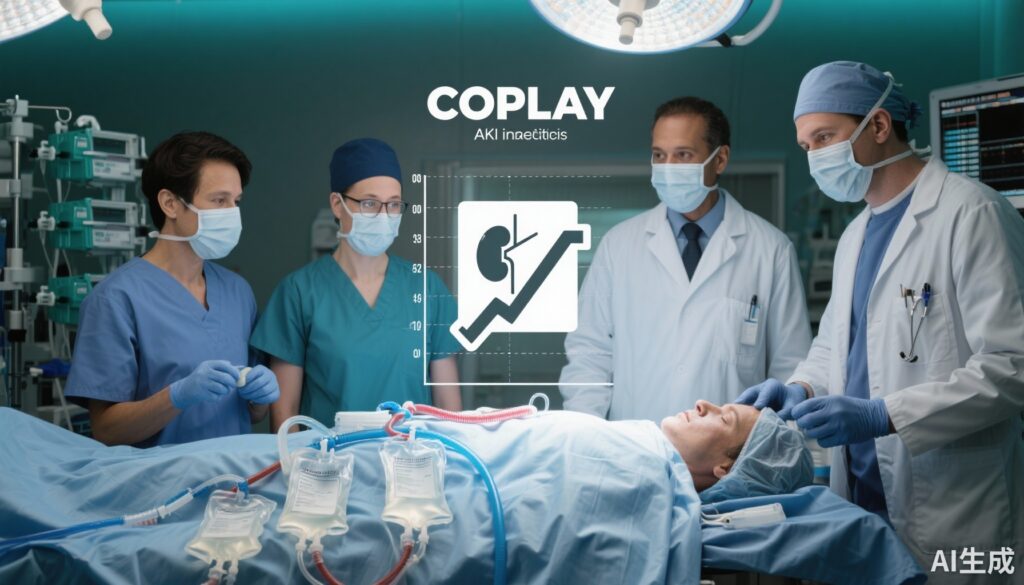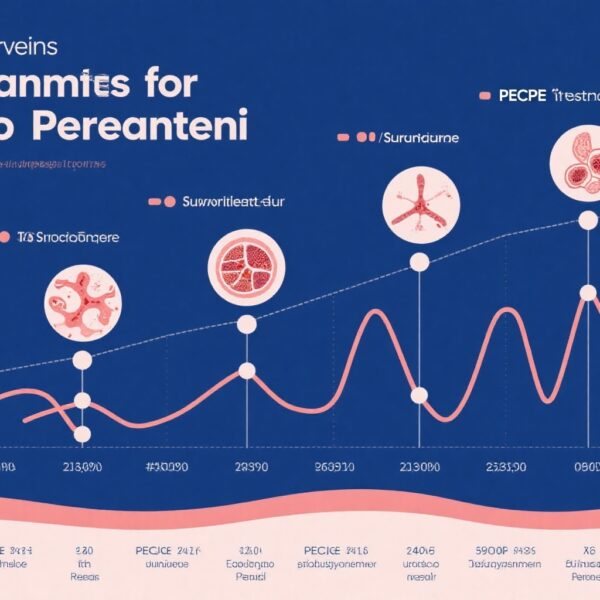Highlights
– In a randomized trial of 168 patients undergoing cytoreductive surgery (CRS) and cisplatin‑based HIPEC for pseudomyxoma peritonei, intraoperative urine‑guided hydration reduced AKI at 7 days from 39.3% to 21.4% (RR 0.55; 95% CI 0.33–0.89; P = 0.012).
– Urine‑criterion AKI (UO <0.5 ml·kg−1·h−1 for ≥6 h) was also reduced (21.4% vs 35.7%; RR 0.60; 95% CI 0.36–0.99; P = 0.040).
– Patients in the urine‑guided arm had fewer major complications within 30 days (36.9% vs 56.0%; RR 0.66; 95% CI 0.47–0.92; P = 0.013) and no increase in adverse events.
Background and clinical context
Acute kidney injury (AKI) is a common and clinically important complication after extensive intra‑abdominal surgery, particularly cytoreductive surgery (CRS) combined with hyperthermic intraperitoneal chemotherapy (HIPEC). Cisplatin, frequently used in HIPEC regimens, has well‑described nephrotoxic potential that is amplified by factors such as hypovolemia, hypotension, and the inflammatory and thermal stresses of major surgery. AKI after CRS‑HIPEC increases perioperative morbidity, length of stay, and may predispose to long‑term renal dysfunction.
Rationale for urine‑guided hydration
Perioperative strategies to reduce cisplatin nephrotoxicity include aggressive hydration and measures to increase urinary flow to limit tubular drug exposure. Monitoring and targeting urine output is simple and widely available intraoperatively. However, whether tightly maintaining a high intraoperative urine output during CRS‑HIPEC reduces postoperative AKI had not been established in randomized trials until the Gao et al. study.
Study design
Gao and colleagues conducted a randomized controlled trial in adults scheduled for CRS and cisplatin‑based HIPEC for pseudomyxoma peritonei between July 24, 2023, and July 18, 2024. Patients (n = 168; mean age 58 years; 66.1% female) were randomized 1:1 to either:
- Urine‑guided hydration: intraoperative goal urine output ≥3 ml·kg−1·h−1 or ≥200 ml·h−1, with simultaneous hydration targeting this urine output.
- Routine hydration: standard intraoperative care targeting urine output ≥0.5 ml·kg−1·h−1.
The primary endpoint was incidence of AKI within 7 days postoperatively, defined by KDIGO criteria (which include changes in serum creatinine and urine output). Analyses were intention‑to‑treat.
Key results
The trial found a clinically meaningful reduction in AKI with urine‑guided hydration:
- AKI within 7 days: 21.4% (18 of 84) in the urine‑guided group versus 39.3% (33 of 84) in the routine hydration group; relative risk (RR) 0.55 (95% CI, 0.33–0.89); P = 0.012.
- AKI identified by urine criteria (UO <0.5 ml·kg−1·h−1 for ≥6 h): 21.4% vs 35.7%; RR 0.60 (95% CI, 0.36–0.99); P = 0.040.
- Major complications within 30 days occurred less frequently with urine‑guided hydration: 36.9% (31/84) versus 56.0% (47/84); RR 0.66 (95% CI, 0.47–0.92); P = 0.013.
- Adverse events were similar between groups, indicating no clear signal of harm from the more aggressive intraoperative hydration protocol.
Interpreting the magnitude and clinical relevance
The absolute reduction in AKI was 17.9 percentage points, corresponding to a relative reduction of approximately 45%. In practical terms, this suggests that for every ~6 patients treated with urine‑guided hydration during CRS‑HIPEC, one episode of AKI within 7 days might be prevented (number needed to treat ≈6). The decrease in major 30‑day complications strengthens the clinical relevance beyond renal outcomes, though causality requires careful interpretation.
Plausible mechanisms
Several mechanisms might explain benefit from urine‑guided hydration. Higher urinary flow reduces the dwell time and concentration of cisplatin and its nephrotoxic metabolites within the renal tubules, diminishing tubular cell uptake and injury. Maintaining intravascular volume and renal perfusion also protects against ischemic insults that exacerbate drug nephrotoxicity. Additionally, intraoperative vigilance on urine output may promote earlier detection and correction of hemodynamic perturbations.
Strengths of the trial
- Randomized design with intention‑to‑treat analysis reduces bias compared with observational work.
- Clinically relevant population undergoing high‑risk surgery with cisplatin exposure.
- Clear, pragmatic intervention (urine output target) that is broadly applicable where intraoperative urine monitoring is routine.
- Report of safety and major complication outcomes in addition to renal endpoints.
Limitations and cautions
Notable limitations temper interpretation and generalizability:
- Potential ascertainment bias: the KDIGO AKI definition includes urine‑output criteria. Because the intervention directly targets urine output, some reduction in AKI incidence may reflect the diagnostic component being manipulated rather than a pure reduction in renal injury. The reported subgroup reduction in urine‑criterion AKI underscores this risk. The summary provided does not detail whether serum creatinine‑based AKI incidence was similarly reduced; that distinction is essential to confirm true nephron‑sparing effect.
- Single disease and regimen: the population was limited to pseudomyxoma peritonei undergoing cisplatin‑based HIPEC. Results may not generalize to other tumors, different HIPEC agents, or patients with different baseline risks.
- Short term AKI outcome window: the primary endpoint was AKI within 7 days. Longer follow‑up is needed to determine effects on persistent renal dysfunction or progression to chronic kidney disease.
- Details about fluid type, total volumes administered, concurrent hemodynamic targets (blood pressure, cardiac output), use of diuretics, and center/centre variability are important for replication but were not available in the summary. Fluid overload risk—particularly in patients with limited cardiac reserve—remains a practical concern despite no observed increase in adverse events.
- Moderate sample size and single (likely single‑center) conduct; findings warrant multicenter confirmation to exclude center‑specific practices influencing outcomes.
Clinical implications and practical considerations
For anesthesiologists and surgical teams managing CRS‑HIPEC with cisplatin, the study suggests that more aggressive intraoperative urine‑guided hydration is feasible and may reduce perioperative AKI and major complications. Implementation would require:
- Accurate, frequent urine measurement and protocolized responses to low urine output (fluid boluses, reassessment of hemodynamics, consideration of vasopressors if hypovolemia is excluded).
- Careful selection of fluid type and monitoring for fluid overload, particularly in patients with cardiac dysfunction or pulmonary disease.
- Integration with broader goal‑directed hemodynamic strategies (e.g., stroke volume variation, cardiac output monitoring) rather than relying on urine output alone.
Research agenda and next steps
Key unanswered questions that a larger confirmatory trial should address include:
- Whether serum creatinine‑based AKI (and biomarkers of tubular injury such as NGAL or KIM‑1) are reduced by urine‑guided hydration, confirming true reduction in renal injury beyond diagnostic effects on urine output.
- Long‑term renal outcomes (e.g., persistent AKI, new‑onset CKD) and patient‑centred endpoints such as hospital length of stay and quality of life.
- Generalizability across tumor types, HIPEC agents, and centers with varied perioperative practices.
- Comparative effectiveness of urine‑guided hydration versus other perioperative kidney‑protective strategies (e.g., forced diuresis with osmotic agents, specific fluid compositions, goal‑directed hemodynamic optimization).
Conclusion
The randomized trial by Gao et al. provides promising evidence that targeting a high intraoperative urine output during CRS and cisplatin‑based HIPEC reduces 7‑day postoperative AKI and major 30‑day complications, without increasing adverse events. While mechanistically plausible and clinically appealing, interpretation requires caution because the intervention directly affects one of the AKI diagnostic criteria. Confirmation in larger, multicenter trials that report serum creatinine and renal biomarker outcomes with longer follow‑up is warranted before widespread adoption as a standard of care. In the interim, teams may consider urine‑guided intraoperative hydration as part of a multimodal renal protection strategy, with careful monitoring for fluid overload and individualized hemodynamic management.
Funding and clinicaltrials.gov
See the original publication for trial funding and registration details: Gao SC, Gao GY, Zhang YX, et al. Anesthesiology. 2025;143(5):1242–1254. DOI: 10.1097/ALN.0000000000005711.
Selected references
1. Gao SC, Gao GY, Zhang YX, Kong H, Xue YY, Wang T, Zuo C, Ma RQ, Wang DX. Effect of Urine‑guided Intraoperative Hydration on Incidence of Acute Kidney Injury after Cytoreductive Surgery and Hyperthermic Intraperitoneal Chemotherapy for Pseudomyxoma Peritonei: A Randomized Trial. Anesthesiology. 2025 Nov 1;143(5):1242-1254. doi: 10.1097/ALN.0000000000005711. PMID: 40801363; PMCID: PMC12513041.
2. Kidney Disease: Improving Global Outcomes (KDIGO) Acute Kidney Injury Work Group. KDIGO Clinical Practice Guideline for Acute Kidney Injury. Kidney Int Suppl. 2012;2(1):1–138.
3. Pabla N, Dong Z. Cisplatin nephrotoxicity: mechanisms and renoprotective strategies. Kidney Int. 2008 Sep;73(9):994–1007. doi:10.1038/sj.ki.5002824.
Author note
This article is intended to summarize and critically interpret the randomized trial by Gao et al. for clinicians and policy‑minded readers. It does not replace reading the original paper for full methodological details and supplementary data.



